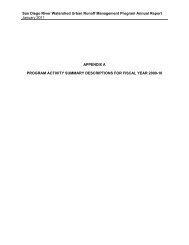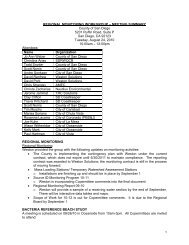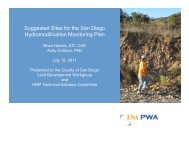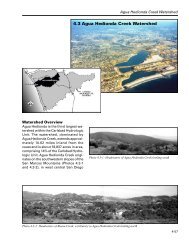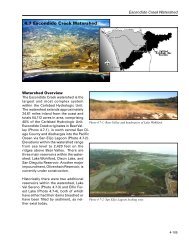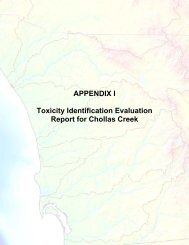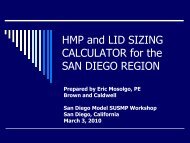APPENDIX I Toxicity Identification Evaluation Reports for Chollas ...
APPENDIX I Toxicity Identification Evaluation Reports for Chollas ...
APPENDIX I Toxicity Identification Evaluation Reports for Chollas ...
Create successful ePaper yourself
Turn your PDF publications into a flip-book with our unique Google optimized e-Paper software.
<strong>Toxicity</strong> <strong>Identification</strong> <strong>Evaluation</strong> of Sweetwater<br />
River Stormwater Using Selenastrum<br />
capricornutum August 2006<br />
out of the nine storm events prior to the 2004-2005 wet weather season. In addition, persistent<br />
toxicity was found because more than 50% of the toxicity tests conducted to date with this<br />
species had a NOEC of less than 100%. The benthic community was determined to be<br />
impacted. Based on these findings it was determined that TIEs would be per<strong>for</strong>med at<br />
Sweetwater River if toxicity was observed during the standard toxicity testing of stormwater<br />
samples during the 2005-2006 monitoring period.<br />
2.1 TOXICITY IDENTIFICATION EVALUATION (TIE) TESTING<br />
The United States Environmental Protection Agency (USEPA) has issued toxicity identification<br />
evaluation (TIE) testing guidelines <strong>for</strong> characterizing chronically toxic effluents (USEPA 1991,<br />
1992, 1993a, and 1993b). These guidelines are often effective <strong>for</strong> effluents that have similar<br />
toxic constituents to those identified in the model effluents used to develop the TIE guidelines.<br />
A <strong>Toxicity</strong> Reduction <strong>Evaluation</strong> (TRE) is an evaluation which involves the identification of<br />
toxicants, location of the source, and treatment of the causative agents to a less toxic <strong>for</strong>m; the<br />
ultimate goal of a TRE is to reduce toxicity associated with contaminated water (or sediment).<br />
Thus, TIEs are important tools used in a TRE to initially help with the identification of toxicants.<br />
The TIE typically consists of three test phases. Phase I of a TIE involves procedures designed<br />
to provide in<strong>for</strong>mation <strong>for</strong> identifying the class of the toxic constituents within an effluent 1 sample<br />
based on their chemical characteristics (e.g., volatility, ionization state, degree of adsorption to<br />
particulates, polarity, oxidative state, or pH sensitivity). These classification characteristics are<br />
examined by comparing the results of tests conducted on unmanipulated effluent samples to<br />
effluent samples that have been physically or chemically manipulated. Phase I testing involves<br />
manipulating the sample at the effluent’s initial pH using some of the manipulations shown in<br />
Table 3 below.<br />
Table 2: <strong>Toxicity</strong> <strong>Identification</strong> <strong>Evaluation</strong> Procedures<br />
Sample Manipulation<br />
Purpose<br />
Ethylenediaminetetraacetic Acid (EDTA) Addition<br />
Detects certain cationic metals (e.g. cadmium)<br />
C 18 Column Extraction with Methanol Elution<br />
Detects non-polar organics and some surfactants<br />
Piperonyl Butoxide Treatment<br />
Detects organophosphate pesticides and pyrethroids<br />
The goal of Phase II TIE testing is to identify the toxicants in the sample, while Phase III<br />
methods are used to confirm that the suspected toxicants are the true cause of toxicity in the<br />
effluent samples (USEPA, 1993a and 1993b). It should be noted that the boundaries between<br />
Phases I, II, and III are not distinct and there may be cases where it is appropriate <strong>for</strong> their<br />
respective procedures to overlap because confirmation in<strong>for</strong>mation can be obtained during<br />
Phases I and II.<br />
1 The USEPA protocol is designed <strong>for</strong> per<strong>for</strong>ming TIEs on effluent samples. However, modifications have been made<br />
<strong>for</strong> testing stormwater samples.<br />
Weston Solutions, Inc. 4







